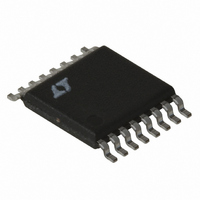LT3430IFE Linear Technology, LT3430IFE Datasheet - Page 14

LT3430IFE
Manufacturer Part Number
LT3430IFE
Description
IC REG SW STDN 3A 200KHZ 16TSSOP
Manufacturer
Linear Technology
Type
Step-Down (Buck)r
Datasheet
1.LT3430EFE-1PBF.pdf
(28 pages)
Specifications of LT3430IFE
Internal Switch(s)
Yes
Synchronous Rectifier
No
Number Of Outputs
1
Voltage - Output
1.2 ~ 54 V
Current - Output
3A
Frequency - Switching
200kHz
Voltage - Input
5.5 ~ 60 V
Operating Temperature
-40°C ~ 125°C
Mounting Type
Surface Mount
Package / Case
16-TSSOP Exposed Pad, 16-eTSSOP, 16-HTSSOP
Lead Free Status / RoHS Status
Contains lead / RoHS non-compliant
Power - Output
-
Available stocks
Company
Part Number
Manufacturer
Quantity
Price
Part Number:
LT3430IFE
Manufacturer:
LT/凌特
Quantity:
20 000
Company:
Part Number:
LT3430IFE#PBF
Manufacturer:
LT
Quantity:
1 030
Part Number:
LT3430IFE#TRPB
Manufacturer:
LT
Quantity:
20 000
Part Number:
LT3430IFE-1
Manufacturer:
LINEAR/凌特
Quantity:
20 000
Company:
Part Number:
LT3430IFE-1#PBF
Manufacturer:
LT
Quantity:
973
Company:
Part Number:
LT3430IFETR
Manufacturer:
TOSH
Quantity:
4 574
Company:
Part Number:
LT3430IFETRPBF
Manufacturer:
LT
Quantity:
5 574
LT3430/LT3430-1
APPLICATIONS INFORMATION
frequency gain of the error amplifi er, including the gain at
the switching frequency. If the gain of the error amplifi er
is high enough at the switching frequency, output ripple
voltage (although smaller for a ceramic output capacitor)
may still affect the proper operation of the regulator. A
fi lter capacitor C
suggested to control possible ripple at the V
Ceramic” solution is possible for the LT3430/LT3430-1
by choosing the correct compensation components for
the given application.
Example: For V
can be stabilized, provide good transient response and
maintain very low output ripple voltage using the follow-
ing component values: (refer to the fi rst page of this data
sheet for component references) C
C
Note 19 for further detail on techniques for proper loop
compensation.
INPUT CAPACITOR
Step-down regulators draw current from the input supply
in pulses. The rise and fall times of these pulses are very
fast. The input capacitor is required to reduce the volt-
age ripple this causes at the input of LT3430/LT3430-1
and force the switching current into a tight local loop,
thereby minimizing EMI. The RMS ripple current can be
calculated from:
Ceramic capacitors are ideal for input bypassing. At
200kHz (100kHz) switching frequency, the energy storage
requirement of the input capacitor suggests that values
in the range of 4.7µF to 20µF (10µF to 47µF) are suitable
for most applications. If operation is required close to the
minimum input required by the output of the LT3430, a
larger value may be required. This is to prevent excessive
ripple causing dips below the minimum operating voltage
resulting in erratic operation.
Depending on how the LT3430/LT3430-1 circuit is powered
up you may need to check for input voltage transients.
14
C
I
= 22nF, C
RIPPLE RMS
(
F
= 220pF and C
)
IN
=
F
= 8V to 40V, V
I
in parallel with the R
OUT
V
OUT
OUT
(
OUT
V
= 100µF. See Application
IN
= 5V at 2A, the LT3430
–
IN
V
= 4.7µF, R
OUT
C
/C
)
/
C
C
V
pin. An “All
IN
network is
2
C
= 3.3k,
The input voltage transients may be caused by input voltage
steps or by connecting the LT3430/LT3430-1 converter to
an already powered up source such as a wall adapter. The
sudden application of input voltage will cause a large surge
of current in the input leads that will store energy in the
parasitic inductance of the leads. This energy will cause the
input voltage to swing above the DC level of input power
source and it may exceed the maximum voltage rating of
input capacitor and LT3430/LT3430-1.
The easiest way to suppress input voltage transients is
to add a small aluminum electrolytic capacitor in parallel
with the low ESR input capacitor. The selected capacitor
needs to have the right amount of ESR in order to criti-
cally dampen the resonant circuit formed by the input lead
inductance and the input capacitor. The typical values of
ESR will fall in the range of 0.5Ω to 2Ω and capacitance
will fall in the range of 5µF to 50µF.
If tantalum capacitors are used, values in the 22µF to
470µF range are generally needed to minimize ESR and
meet ripple current and surge ratings. Care should be taken
to ensure the ripple and surge ratings are not exceeded.
The AVX TPS and Kemet T495 series are surge rated. AVX
recommends derating capacitor operating voltage by 2:1
for high surge applications.
CATCH DIODE
Highest effi ciency operation requires the use of a Schottky
type diode. DC switching losses are minimized due to its
low forward voltage drop, and AC behavior is benign due
to its lack of a signifi cant reverse recovery time.
The use of so-called “ultrafast” recovery diodes is generally
not recommended. When operating in continuous mode,
the reverse recovery time exhibited by “ultrafast” diodes
will result in a slingshot type effect. The power internal
switch will ramp up V
tempt to get it to recover. Then, when the diode has fi nally
turned off, some tens of nanoseconds later, the V
voltage ramps up at an extremely high dV/dt, perhaps 5 to
even 10V/ns ! With real world lead inductances, the V
node can easily overshoot the V
IN
current into the diode in an at-
IN
rail. This can result in
SW
node
34301fa
SW













